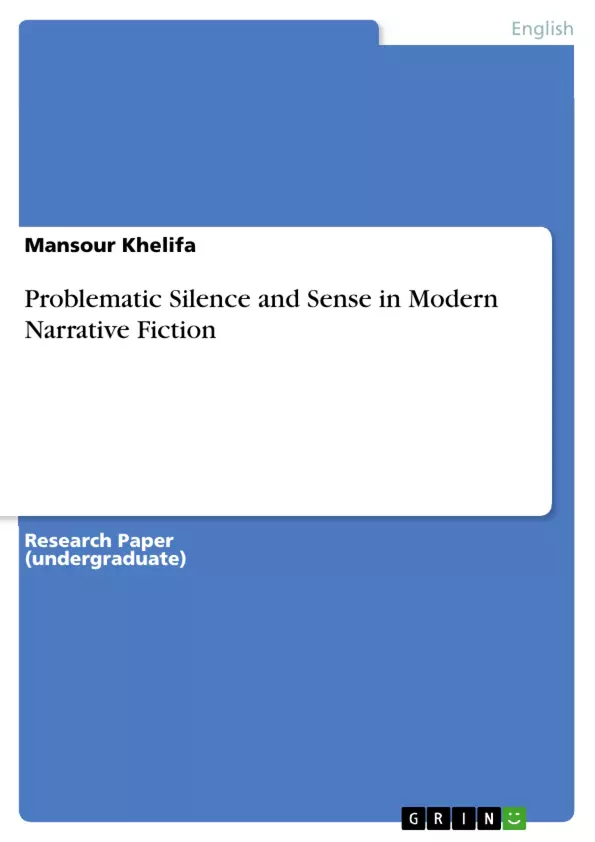From the start, as the writer of fiction puts pen to paper, s/he is met with the dumbness of the blank space of the page and challenged by a welter of questions: How to begin? What to say? How to inform silence? How to make sense and coherence out of inchoate amorphousness? How to account for the lived experience? The novel’s primary aim is to tell a story, according to E. M. Forster in his not-so-antiquated "Aspects of the Novel".
The narrated story, more often than not, voices silent characters whose histories and frames of mind are revealed by an external agent/consciousness (the narrator/the author/another character/a godlike or limited viewpoint). Occasionally, the story tells itself in the form of first-hand dramatised dialogues when the characters assume some distinct voice of their own, different from, and / or blending with, that of a third-person narrator/godlike author.
Inhaltsverzeichnis (Table of Contents)
- Problematic Silence and Sense
- Silence and Sense in Modern Narrative Fiction
- The Problematic Notion of “Silence and Sense”
- Silence and Sense in Woolf’s Mrs Dalloway
- Silence and Sense in Joyce’s A Portrait of the Artist as a Young Man
- Silence and Sense in Lawrence’s Women in Love
- The "Unsaid" Parts of Novelistic Discourse
- Silence and the "Silent Polyphony"
- Stream of Consciousness and its Functions
Zielsetzung und Themenschwerpunkte (Objectives and Key Themes)
This text aims to explore the concept of "silence and sense" in modern narrative fiction, focusing on the use of silence as a narrative tool and its relationship to character development, meaning-making, and the indeterminacy of meaning.
- The role of silence in creating narrative space and ambiguity
- The relationship between silence, character instability, and the indeterminacy of meaning
- The use of stream of consciousness to represent the unspoken and the inner workings of characters' minds
- The interplay between dialogism and silence in shaping narrative discourse
- The application of psychoanalytic theory to understanding the "unsaid" parts of novelistic discourse
Zusammenfassung der Kapitel (Chapter Summaries)
The text begins by discussing the concept of silence as a narrative device in modern fiction, arguing that silence is not simply an absence of speech but a dynamic element that contributes to the creation of meaning and the exploration of character. The author then focuses on three specific novels: Virginia Woolf's *Mrs Dalloway*, James Joyce's *A Portrait of the Artist as a Young Man*, and D. H. Lawrence's *Women in Love*, analyzing how each novel utilizes silence and stream of consciousness to represent the complex inner lives of its characters.
The text explores how these novels utilize silence to express the characters' emotional states, the unspoken desires and anxieties that underlie their words and actions. The author also considers how these novels challenge traditional notions of narrative voice and authorial control, demonstrating how silence can be a powerful tool for creating ambiguity and unsettling reader expectations. The text further examines the influence of Bakhtin's theories of dialogism and heteroglossia on the understanding of silence in modern fiction, exploring how silence emerges from the interplay of multiple voices and perspectives within the narrative.
The text then delves into the psychoanalytic dimension of silence, drawing upon the works of Julia Kristeva and Jacques Lacan to analyze how silence functions as a means of representing the unconscious, repressed desires, and the complex relationship between language and the unspoken. The author explores how silence can be a manifestation of a character's internal struggles, their anxieties, and their attempts to grapple with the complexities of existence.
Schlüsselwörter (Keywords)
The key concepts and themes explored in this text include: silence, sense, modern narrative fiction, stream of consciousness, dialogism, heteroglossia, polyphony, interior monologue, psychoanalysis, repressed desire, unconscious, the unspoken, character development, indeterminacy of meaning, and narrative space.
- Quote paper
- Mansour Khelifa (Author), 2009, Problematic Silence and Sense in Modern Narrative Fiction, Munich, GRIN Verlag, https://www.grin.com/document/314256



